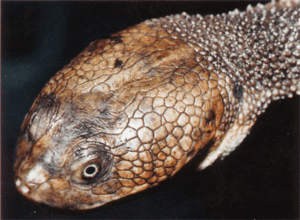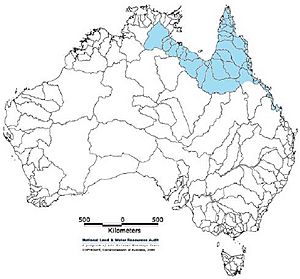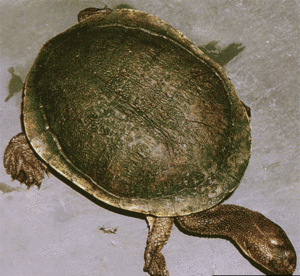Cann's snake-necked turtle facts for kids
Quick facts for kids Cann's snake-necked turtle |
|
|---|---|
 |
|
| Conservation status | |
| Scientific classification | |
| Genus: |
Chelodina
|
| Species: |
canni
|
 |
|
| Distribution of C. canni in Australia. | |
| Synonyms | |
|
|
The Cann's snake-necked turtle (scientific name: Chelodina canni) is a special type of turtle. It lives in the northern and northeastern parts of Australia. This turtle is known for its long, snake-like neck.
For many years, people thought this turtle was the same as the New Guinea snake-necked turtle. However, scientists later discovered they were different. In 2002, it was officially named a unique species. It can sometimes breed with the Eastern long-necked turtle where their homes meet.
About Cann's Snake-Necked Turtle
What Does It Look Like?
Adult Cann's snake-necked turtles have a wide, round shell called a carapace. This shell is usually smooth, with a small dip in the middle. Their belly shell, called a plastron, is wide and yellow. It often has dark lines where the shell plates meet.
Their head is wide, and their head, neck, and legs can have a reddish or pinkish color. They also have small, blunt bumps on their neck. Baby turtles, called hatchlings, have bright orange-red patterns. These patterns are on their belly, head, neck, and even on the edges of their top shell.
Where Do They Live?
Cann's snake-necked turtles live in the freshwaters of northern Australia. You can find them in the Roper River area in the Northern Territory. They also live in rivers that flow into the Gulf of Carpentaria in northwest Queensland.
Further east, they are found in Cape York Peninsula. Their range extends from Cairns in the north down to Rockhampton in the south. In the Rockhampton area, they sometimes mix and breed with the Eastern long-necked turtle. This area is called a "hybrid zone."
How Scientists Classify Them
Naming the Species
Scientists group living things into categories. This helps them understand how different species are related. The Cann's snake-necked turtle belongs to:
- Order: Testudines (this group includes all turtles and tortoises)
- Suborder: Pleurodira (turtles that bend their neck sideways to hide their head)
- Family: Chelidae (a family of turtles found in Australia, New Guinea, and South America)
The first official example of this species, called the "holotype," is a female turtle. It was found at Malogie Waterhole in the Northern Territory, Australia.
Why the Name "Cann's"?
This turtle is named after a very important person, John Robert Cann. He was born in 1938 and lives in Sydney, Australia. John Robert Cann spent his whole life studying and working with Australia's freshwater turtles. Naming the turtle after him is a way to honor his dedication.
A Bit of History
For a long time, scientists thought this turtle was the same as the New Guinea snake-necked turtle. But some people started to think they were different. In 1985, an attempt was made to name it Chelodina rankini. However, this name was not properly published, so it wasn't official.
Finally, in 2002, two scientists, William McCord and Scott Thomson, officially described it as a new species. They gave it the name Chelodina canni. This showed that it was truly unique and not the same as the New Guinea turtle.
See also
 In Spanish: Tortuga de cuello de serpiente de Cann para niños
In Spanish: Tortuga de cuello de serpiente de Cann para niños




